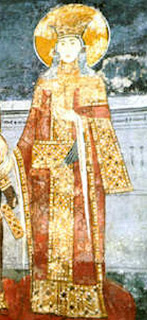
 Speaking of Maria of Trebizond and her riding outfit, I have been looking for all the upper-class ladies I can find from the last decades of the Empire, trying to find a gown suitable for wearing on a horse. Most imperial ladies are shown dressed something like Jelena of Serbia in the mid-1300s (left) or Maria's mother-in-law, Helena. Bulky. Stiff. Important. These images were not intended as fashion statements, but as statements of empire.
Speaking of Maria of Trebizond and her riding outfit, I have been looking for all the upper-class ladies I can find from the last decades of the Empire, trying to find a gown suitable for wearing on a horse. Most imperial ladies are shown dressed something like Jelena of Serbia in the mid-1300s (left) or Maria's mother-in-law, Helena. Bulky. Stiff. Important. These images were not intended as fashion statements, but as statements of empire.Clearly such robes were not for riding astride. However, a contemporary image turned up of a delectable blonde, Anna Radene Lemniotida from Kastoria. She has a an important hat, masses of carefully-maintained curls, big earrings, a wide cloak. Sixteen rings on her long slender fingers. Her red robe has huge hanging sleeves, and I bet there is enough fabric in the rest of it to accommodate riding astride quite easilly. This is not a definitive solution, but it is interesting.
* * * * *
Then there is the question of porphyrogennetos. The Oxford Dictionary of Byzantium avoids making a commitment here, and Wikipedia doesn't quite get it. Recall that Sphrantzes said that -- this was at the point when John had died, before Constantine arrived in Constantinople -- Sphrantzes said that Demetrios was not a despot and "porphyrogennetos according to the custom of Constantinople." [Late note: either Sphrantzes was lying, or he forgot: Demetrios had been Despot of Lemnos for 15 years.] What he meant by "the custom of Constantinople" has been a problem. For a long time porphyrogennetos described an imperial child born in a special pavilion at the palace set aside for births. It was lined with porphyry, perhaps, or hung with purple curtains, and porphyrogennetos means "born in the purple." But that pavilion fell down or out of use by the 11th century.
 A close examination of the texts on this splendid family portrait, painted in a manuscript to be sent to Paris about 1403, gives a clue. The texts, three for the boys, and two for their parents (not shown here), are crammed with titles. Manuel is pistos basileus, autokrator and augustos. Helena, augusta and autokratorisa. John, the oldest son, dressed like his father, is also pistos basileus. Theodoros, the second son, porphyrogennetos. Andronikos, the youngest at that point, authentopoulos, which means "true son."
A close examination of the texts on this splendid family portrait, painted in a manuscript to be sent to Paris about 1403, gives a clue. The texts, three for the boys, and two for their parents (not shown here), are crammed with titles. Manuel is pistos basileus, autokrator and augustos. Helena, augusta and autokratorisa. John, the oldest son, dressed like his father, is also pistos basileus. Theodoros, the second son, porphyrogennetos. Andronikos, the youngest at that point, authentopoulos, which means "true son."John's title, basileus, means that his father had chosen him as successor to the throne of the Eastern Empire, and Westerners called him "the little king." Theodoros called himself porphyrogennetos in a poem he wrote for his parents. By analogy with basileus, and with the fact that a "true son" in Greco-Roman tradition means that a child was so recognized by his father, it seems clear that porphyrogennetos in this case was a title given by the the emperor who was also the father.
The texts on this image help make clear what is meant where, one page after the passage in Sphrantzes where it says that Demetrios was not a despot and porphryogennetos, a subsequent passage says that "the despot and porphryogennetos, Lord Demetrios, went to the Morea."
So when Constantine arrived in Constantinople as Emperor, he appointed Demetrios (who was already there trying desperately to be Emperor) to serve as Despot along with Thomas. Both Demetrios and Thomas signed their documents as porphyrogennetos. Demetrios did not have the title of porphyrogennetos at the time when John died, but Constantine as Emperor gave him the title with the appointment.
"After the custom of Constantinople," is a red herring. Sphrantzes was devoted to the memory of Manuel II, for whom he began working when he was a child. He would writing nothing that might possibly be construed as the remotest criticism of his beloved Emperor, and, of course, everyone who was anyone would understand what "after the custom of Constantinople" meant.
This is a great blog! I love the pictures of the gowns. Some of them look more comfortable than others :) As an aside note, they actually do make gowns especially for riding, in special ceremonies like horseback weddings. We got ours made from a store on http://www.gatheringguide.com and they said it wasn't at all uncommon of a request. Then again, we live in horse country :)
ReplyDeleteIt's so nice to find a comment a year and a half after the blog was posted. I have an article by a fabrics specialist who says that Byzantine fabrics were generally not comfortable, so that makes me more curious about what women actually wore.
ReplyDelete